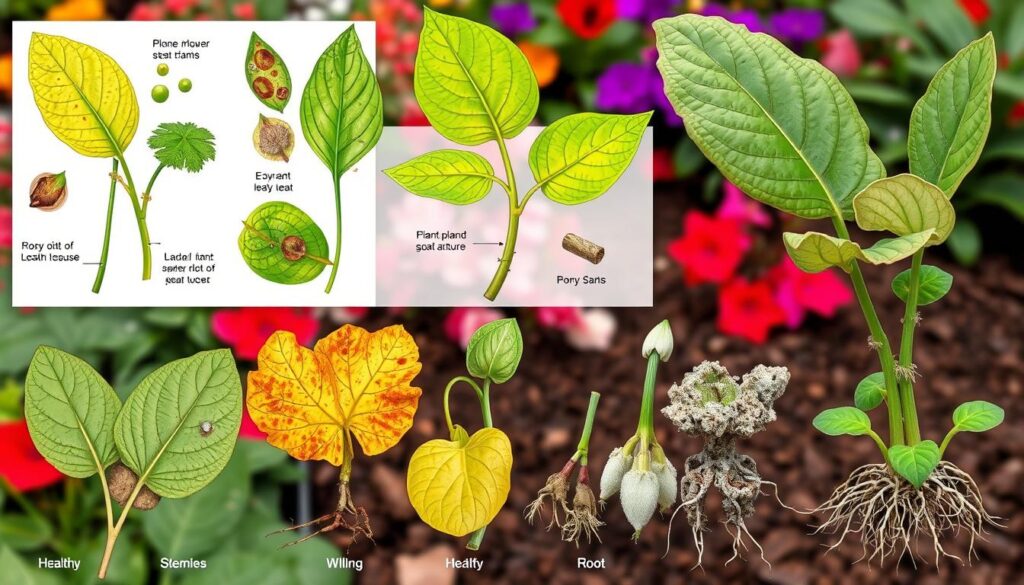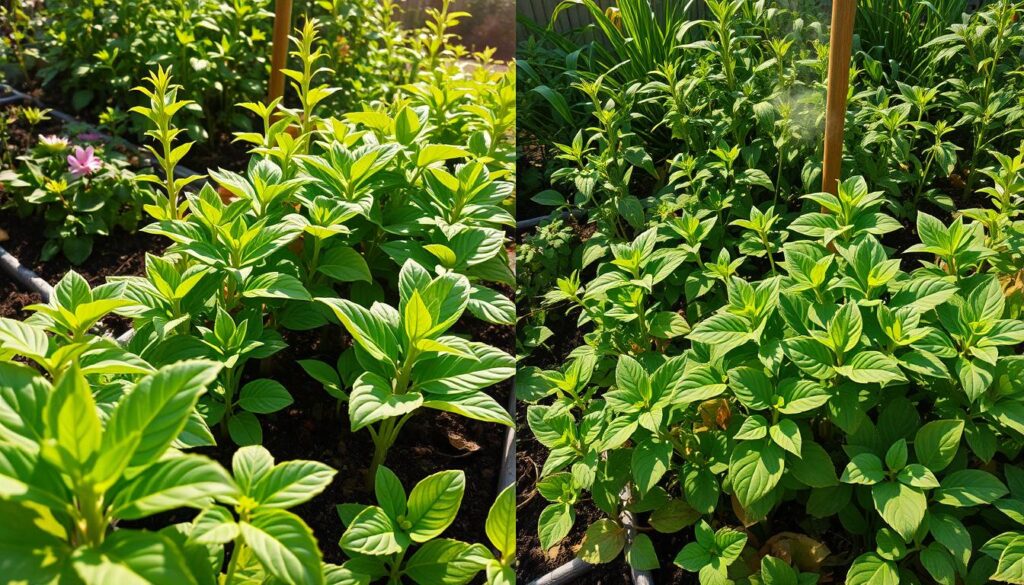Every garden has a story of growth and beauty. But, what if disease ruins that story? Disease can harm your plants, making it crucial to control it. Knowing how to identify and solve plant diseases is key to protecting your garden.
When plants look sick, they need our help. We must understand the different diseases that can harm plants. This guide will help you identify common diseases and find ways to fix them. You’ll learn how to keep your garden healthy and thriving.
Key Takeaways
- Understanding the importance of quick and accurate plant disease identification to maintain garden health.
- Exploring traditional and innovative techniques for plant disease control.
- Identifying actionable and effective plant disease solutions for gardeners.
- Learning to recognize early signs of stress and disease in plants is key to their recovery.
- Prevention is just as crucial as treatment in the realm of plant health.
Understanding Common Plant Diseases and Their Impact on Gardens
Garden health is often at risk from common plant diseases. These diseases can harm the environment and economy if not managed. It’s vital for gardeners to know about these diseases and their effects on plants.
Plant diseases take many forms, each causing damage. Fungi, bacteria, and viruses are common culprits. They spread fast and can destroy gardens if not controlled. Garden pests make things worse by spreading diseases from plant to plant.
The economic damage is significant. Commercial growers face big losses due to disease. They spend more on prevention and treatment, increasing costs.
- Early detection of symptoms
- Regular monitoring for garden pests
- Implementing effective containment strategies
Chemical treatments for diseases and pests pollute soil and water. This harms biodiversity and ecosystem health.
The table below shows some destructive plant diseases, their signs, and affected plants:
| Disease | Common Signs | Affected Plants |
|---|---|---|
| Powdery Mildew | White or gray powder on leaves, stems | Roses, apples, grapes |
| Botrytis Blight | Gray mold on flowers, leaves, or stems | Strawberries, grapes, peonies |
| Rust | Orange or yellowish powdery spots on undersides of leaves | Beans, tomatoes, roses |
In conclusion, the impact of plant diseases is huge. It affects gardens and farms. By learning about these threats, gardeners can protect their plants and help the environment.
Key Symptoms of Plant Diseases and How to Spot Them in Your Garden
Finding plant diseases early is key to a healthy garden. Knowing the signs can help you act fast. Here, we’ll cover the main symptoms and how to spot them.
Discoloration and Visible Signs on Leaves
Discolored or deformed leaves are a clear sign of trouble. These signs often mean a plant needs help. Watch for:
- Yellowing or browning leaves
- Spots or blisters on leaf surfaces
- Edges of leaves turning brown or crispy
Stunted Growth and Deformities in Plants
Stunted growth or plant deformities are also warning signs. They might mean the plant lacks nutrients or is sick. Look for:
- Unusually small leaves or flowers
- Twisted or warped stems and leaves
- Overall reduced growth compared to healthy specimens
Evidence of Mold and Mildew on Plant Surfaces
Mold and mildew are common, especially in damp places. A fuzzy or powdery look on plants is a fungal sign. It’s important to catch these early to stop them from spreading. Look for:
- White, gray, or greenish mold on leaves or stems
- Sooty black mold coating on upper or lower leaf surfaces
Regular monitoring is crucial for managing plant diseases. Catching signs early and acting fast can keep your garden thriving.
Root Rot: Causes, Prevention, and Treatment
Root rot is a big problem in gardening, attacking plants at their roots. It’s important to know how to prevent and treat it to keep your garden healthy.
Poor drainage is the main cause of root rot. It lets fungi and other pathogens grow in too much moisture. These pathogens can quickly damage the plant’s roots, causing health problems and even death.
- Improving soil drainage: Making your soil drain better is key to preventing root rot. Use well-draining soil mixes and add compost to improve soil structure.
- Proper watering techniques: Don’t overwater your plants. Water them right for their needs to avoid too much moisture around the roots.
- Regular monitoring: Check your plants’ roots often. If you see discolored, soft, or smelly roots, act fast.
If you find root rot, treat it quickly. Remove the affected plant to stop it from spreading. Cut out the bad roots and put the plant in new, clean soil to save it.
| Condition | Prevention Method | Treatment Option |
|---|---|---|
| Mild Root Rot | Adjust watering schedule | Trim infected roots, repot |
| Advanced Root Rot | Improve soil drainage | Use fungicides or remove plant |
Managing root rot needs both prevention and quick action. With the right steps, gardeners can keep their plants strong and healthy. Remember, a plant’s health starts with its roots.
The Fight Against Fungal Infections in Plants
To fight fungal infections in plants, you need to know about plant fungus and how to prevent it. We will cover the types of fungal agents that harm plants. We’ll also talk about treating and preventing these infections.
Identifying Different Types of Plant Fungus
Starting with the right identification is key to managing fungal infections. Common culprits include powdery mildew, botrytis, and rust fungus. These fungi show up as white dust, gray mold, and flecked leaves on plants.
Must-Follow Steps for Treating Fungal Diseases
Acting fast when you see fungal diseases can save many plants. Here are some important steps:
- Keep infected plants away from others to stop the fungus from spreading.
- Get rid of and destroy any parts of plants that are badly affected.
- Use fungicides that match the type of fungus you found.
- Make sure plants have enough air around them to prevent fungus growth.
Implementing Fungal Disease Prevention Strategies
Preventing fungal infections is better than treating them. Here are some strong ways to prevent fungal diseases:
- Keep the humidity in your garden at a moderate level to stop fungus from growing.
- Water plants in the morning so they can dry out during the day.
- Rotate crops and choose plants that are less likely to get infected.
- Check plants often for early signs of infection to deal with them quickly.
By following these steps, you can not only manage current fungal infections but also stop them from coming back. This will keep your plants healthy and your garden looking great.
Bacteria and Viral Infections: Diagnosis and Management
Understanding and controlling bacterial infections in plants and viral infections is key in plant disease management. Unlike fungal infections, bacterial and viral pathogens are often less obvious. They show symptoms that are harder to spot and need quick action.
Bacterial infections can cause leaf spots, wilts, and galls. These can be found with tests like ELISA and PCR. Viral infections show up as mosaic patterns, stunted growth, and curled leaves. They also need lab tests to confirm the virus.
To manage plant disease well, we need to use many methods:
- Cultural practices: Remove infected plants, use the right water, and rotate crops.
- Biological controls: Use bacteriophages or good microbes to fight pathogens.
- Chemical treatments: Use bactericides or virucides when needed, but be careful not to build up resistance.
Preventing infections is also very important. Keep plants clean, use resistant plants, and keep them healthy with the right food and care. This can really help lower infection rates.
| Infection Type | Common Symptoms | Recommended Management Practices |
|---|---|---|
| Bacterial | Leaf spots, wilts, galls | Laboratory diagnosis, bactericides, crop sanitation |
| Viral | Mosaic patterns, stunted growth | Resistant varieties, hygiene, viral detection tests |
Fighting bacterial and viral infections in plants is a big challenge. It needs constant research and new plant disease management plans. This helps keep plants healthy and crops productive.
Common Plant Diseases: Identification and Effective Solutions
Keeping your garden healthy means tackling common plant diseases. This part covers how to spot diseases and find solutions. It helps keep your garden thriving for a long time.
Methods for Accurate Plant Disease Identification
Spotting plant diseases right is key to fixing them. Start by looking closely at symptoms and think about your garden’s environment. You might also want to talk to gardening experts. Tools like magnifying glasses or plant health apps can help you get it right.

Comprehensive Solutions for Garden Health
Keeping your garden healthy needs a mix of methods. This includes good gardening habits, choosing strong plants, and using safe pesticides:
- Cultural practices: Make sure plants have enough space, change what you grow, and water right.
- Resistant varieties: Pick seeds that fight off diseases to cut down on problems.
- Environmental controls: Get rid of plant waste to stop diseases from spreading.
These steps are key to solving common plant diseases. They show how important it is to know what’s wrong and fix it right.
Integrated Pest Management: Controlling Garden Pests Linked to Diseases
Integrated pest management (IPM) is a green way to fight garden pests that harm plants. It mixes different methods like using living organisms, changing how plants grow, and using chemicals. This approach keeps pests under control while protecting the environment and keeping plants healthy.
- Pest identification: Accurate identification is crucial for effective control strategies.
- Monitoring and assessment: Regular observation helps determine if and when actions should be taken.
- Prevention: This is the first line of defense in reducing the onset of pests and related diseases.
- Control: Implementing the least disruptive control methods with a focus on long-term pest reduction.
IPM doesn’t just fight garden pests. It also stops plant diseases from spreading. This makes gardens healthier. Using IPM helps plants grow strong and live longer.
Incorporating IPM into your gardening practices transforms your approach from reactive to proactive, focusing on preventing problems before they become severe.
By using IPM, gardeners can manage pests well. This also helps control plant diseases. It makes plants healthier and keeps the garden balanced.
Natural vs. Chemical Controls for Plant Disease Treatment
In the garden, we face many battles against plant diseases. We use natural remedies and chemical controls to fight them. Each method has its own strengths and weaknesses, affecting how we manage plant health.
Pros and Cons of Natural Remedies
Natural treatments are loved for being safe for the environment and wildlife. They include composting, crop rotation, and organic fungicides. These methods are good for the soil and are sustainable. But, they might take longer to work and can vary based on the environment.
When to Consider Chemical Interventions
Chemical controls are key in fighting plant diseases. They work fast and can save crops and plants from severe outbreaks. But, they can be harmful to other living things and the environment. So, we must think carefully before using them.

Choosing between natural and chemical treatments doesn’t mean you have to pick just one. Many gardeners and farmers use both. They use chemicals when needed but prefer natural methods to keep their gardens healthy and balanced.
Tools and Resources for Plant Disease Identification
In gardening, knowing plant diseases quickly is key. The right resources for plant disease identification help gardeners and pros. They lead to healthier gardens and better plant diseases solutions.
Many tools and resources are available. Guidebooks, online databases, and mobile apps help diagnose and manage plant diseases. They offer detailed guidance.
- Guidebooks: Available in print and digital, these books are full of information. They include photos and descriptions of symptoms.
- Online Databases: These sites give quick access to lots of plant disease data. They have high-quality images and treatment options.
- Mobile Apps: These apps are easy to use. They let you take pictures of sick plants and get quick advice.
Using these tools helps identify and treat plant diseases fast. For gardeners wanting healthy, beautiful gardens, learning about these resources is crucial.
Modern technology is key in plant health management. It shows how new gardening tech can fight plant problems better than before.
By using resources for plant disease identification, gardeners and horticulturists can tackle any plant health issue. This promotes a strong and thriving garden environment.
Creating a Plant Disease Control and Maintenance Schedule
To keep gardens healthy, a detailed maintenance plan is crucial. This plan helps keep plants disease-free and vibrant all year round. It’s a proactive way to ensure your garden stays strong and beautiful.
Regular Monitoring and Inspection of Plants
Watching your plants closely is essential. Regular checks can spot problems early. This is especially important when plants are growing fast and are more at risk.
Seasonal Practices for Plant Health and Vigor
Adding seasonal care to your routine helps your garden thrive. Each season brings its own challenges and opportunities. Tailor your care to meet these needs.
- Spring: Focus on preventive measures against moisture-related diseases as plants start to grow actively.
- Summer: Prioritize hydration and sun protection to keep plants robust and disease-free.
- Fall: Prepare plants for cooler weather by strengthening their defenses against the cold.
- Winter: Continue monitoring for signs of stress or damage from cold, providing protections where necessary.
| Season | Key Activities | Focus Area |
|---|---|---|
| Spring | Pruning, early pest control | Plant growth stimulation, disease prevention |
| Summer | Water management, weed control | Hydration and protection |
| Fall | Soil maintenance, mulching | Root protection, disease resistance |
| Winter | Cover crops, structural supports | Cold stress mitigation, structural integrity |
Conclusion
We’ve explored garden maladies from start to finish. We learned how to prevent and solve common plant diseases. A healthy garden isn’t just about fighting diseases when they show up. It’s about a whole approach to keeping plants safe.
Being watchful for early signs and knowing how to act can really help. This way, our gardens stay strong and healthy. It’s all about knowing when and how to tackle each problem.
We’ve talked about why preventing plant diseases is crucial for gardening. Using methods like Integrated Pest Management helps a lot. It’s about using both natural and chemical ways to keep plants safe.
Effective solutions range from simple checks to complex disease management. Each step is important for a disease-free garden. It shows how important it is to be educated and proactive in plant care.
In the end, gardeners face many challenges from plant diseases. But, with the right knowledge, we can overcome these obstacles. By focusing on education and prevention, we can grow gardens that are beautiful and full of life.
FAQ
How can I identify common plant diseases in my garden?
To spot common plant diseases, look for signs like leaf discoloration, stunted growth, and plant deformities. Also, check for mold or mildew on the plants. Each disease has its own signs, so it’s important to watch your plants closely.
What are the most effective solutions for plant disease control?
Good solutions include cultural practices like watering right and spacing plants well. Biological controls like beneficial insects or microbes are also effective. Chemical treatments should be used carefully and only when needed. Using a mix of these methods is the best way to control diseases.
What should I do if I suspect my plants have root rot?
If you think your plants have root rot, act fast. Take the plant out of the soil and check the roots. Healthy roots are firm and white, while bad ones are soft and brown or black. Cut out the bad roots, put the plant in new soil, and change how you water to stop it from coming back.
How can I protect my plants from fungal infections?
To keep plants safe from fungi, make sure air moves well, don’t water from above, and use fungicides if needed. Also, remove sick parts and keep your garden clean to stop fungi from spreading.
Are there natural remedies for treating plant diseases?
Yes, natural remedies like neem oil, baking soda solutions, and compost tea can help with plant diseases. They work for some problems but might not be enough for serious cases.
Can you provide tips for preventing plant diseases?
To prevent diseases, choose plants that are resistant, give them the right food and water, and make sure they have enough space and air. Keep the soil healthy and check your plants often. Acting fast when you see a problem can really help.
What are some common garden pests that can lead to plant diseases?
Pests like aphids, whiteflies, spider mites, and slugs can harm plants and spread diseases. Controlling these pests is key to keeping your plants healthy.
Where can I find helpful resources for plant disease identification?
You can find many resources for identifying plant diseases. Look for guidebooks, visit agricultural extension services, use online databases, or download garden care apps. These tools can help you figure out what’s wrong with your plants quickly.


